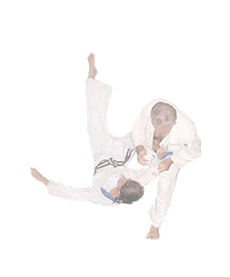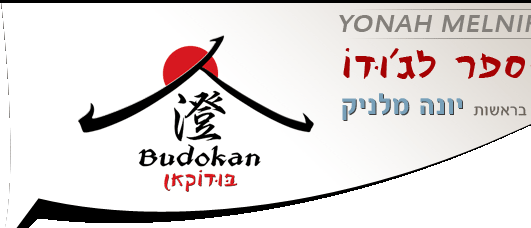



|
| Judo in Adulthood
By: Dr. Margalit Schwartz Overview
The public usually comes into contact with judo through two media: T.V broadcasting of important competitions and their children's judo classes. Thus, with most people, adults or kids, judo is associated with people wearing white (or blue) "pyjamas" whose age is between 4 and 30 at the most. If there are older faces in the picture, they are probably standing aside the mat and shouting or wandering about among the fighting youngsters, wearing ties and suits and making strange gestures. Adults on the judo mat can be divided into two main groups: 1. Veteran judokas that have been active in judo from a young age, with past competitive experience, who continue to be active for pleasure or as teachers and coaches 2. Adults who were never active before in judo and discover it at an older age in various ways. Anyway, both are much smaller in number than youth. Although this picture describes the situation quite accurately, it is not precise, and it is a relatively new situation. In the past, adults were much more naturally active in judo and even today we can see them in some other countries but not so much here, in Israel. This occurrence is related mostly to the evolution process judo has undergone since it’s birth in 1882. The most significant changesoccur in the last forty years. The Original Goals of Judo – and the Changes
Jigoro Kano, the founder of judo, aimed to develop a method of physical and mental education that would be available to all. He was first and foremost an educator and his goals were chiefly educational. He envisioned physical education as an integral part of education as a whole. Thus, he was determined to spread his method throughout the schools, and saw to it that the main principles of the method be those of gentleness, maximum efficiency, mutual benefit and the natural and harmonious flow between the two partners. Nourishing each other, keeping the safety of each other and thus developing together. He disqualified dangerous techniques and emphasized the effective use of energy and flowing movement as opposed to strength. He and his disciples trained continuously until a dvanced age. For a more comprehensive study on this subject, thereader is referred to anther article: The History of Judo – Highlights His dream was to see judo spread throughout the world to the benefit of all society and considered this as part of Japan’s contribution to the world. This development did indeed occur over the years. For reasons not to be dealt with here, the competitive aspect of judo developed much more than its other aspects. This development undoubtedly brought about a significant improvement in judo technique, but also caused judo to become an almost exclusively competitive sport. It is no secret, for example, that countries invest large amounts of money in the building of champions. In this issue, political struggles are often involved with a great waste of energy, contrary to the maximum efficiency principle of Kano. This was not the original intention, certainly not the only intention. The competitive aspect of judo was, and remains important. Butit is under no circumstances the only one. The Richness of the Art of Judo
One should envisage judo from a much wider perspective. Judo is by no means a competitive sport only. We see in judo an expansive art of movement which is first of all method of comprehensive physical education. We approach judo as a great circle in which everyone can find his place according to his needs, wishes and inclinations. Judo offers a “way” or “path” (according to its name) by which everyone can improve and develop in various important aspects of daily life; physical, personal and interpersonal. The subject of judo for kids in different developmental phases and how it can be utilized correctly, is discussed in another article: Judo for Kids by Sensei Yonah Melnik. Here, we will expand our discussion of judo’s contribution to adults. The Contribution of Judo to Adults
The physical aspect
Judo training provides a method for physical activity which improves all the components of physical ability: aerobic (cardio- respiratory capacity), anaerobic, strength, flexibility, agility and coordination. The uniqueness of judo is such that it allows training all or most of these components simultaneously. The judoka can regulate his practice according to his needs and his abilities, and emphasize those components he mostly wants to improve. Another unique feature is that the judoka can do all this without the monotony that sometimes exists in other methods. The judoka is constantly in a changing and dynamic situation and in a process of constantly discovering new movement possibilities and patterns. His development process occurs in a wonderful aesthetic experience. He will find that his body movement gets smoother, that his posture stabilizes and attains levels of efficiency not before experienced. The personal aspect
Judo training is based on working with a partner. The student starts to confront others. Gradually, he reveals his ability a nd begins to develop confidence in himself and in his body. Feelings ofhelplessness and a sense of defeatedness will gradually disappear and the judoka will learn to rely upon his ability to defend himself in dangerous situations. He will go through aesthetic experiences related to his body which will improve his body image and self image. An adult used to the image of “two left hands”, “does not recognize right from left” will have to gradually give up this negative self image. The question “is it possible to change such features at an adult age?” will be no longer relevant. The interpersonal aspect
Here we may find the most unique contribution of judo. In the previous chapter, we described the evolution of the sense of security from the personal standpoint. But there is more than this experience only. Judo is a form of contact with the other, the training partner. The training session is carried out in this unique space between the two partners. This is a very special kind of contact: on the one hand it is a confrontation and even a contest, but on the other hand the technical skills develop as a result of focused tuning and listening to the body language of one’s self and one’s partner. There is, under no circumstances, strength pitted against strength. This is negative judo! Let us see it in another light: the judoka learns to feel the movement and the reactions of his partner and to respond accordingly. He learns to utilize the strength of his partner to his own benefit. He learns how to optimally use the energy found in natural body movement, his own and that of his partner. He learns to use precise timing instead of strength. Through this process, he learns to recognize his responses to others and their responses to him in turn. Because body language is a wonderful means of self expression, the judoka learn to know himself, as he relates to others in all fields. I will give simple examples to clarify my meaning. The judoka will quickly identify to what degree he is stiff and how it is difficult for him to soften his reactions? Is his body movement sharp and hard, or is it gentle and rounded? Is he inclined to be defensive or is he quick in attacking even in an uncalculated way? Is he concerned with protecting and watching over his partner or does he find it difficult to take responsibility for him? He will certainly receive feedback from all his different partners concerning these questions, and in turn, will offer them his own feedback. In this way a dialogue starts to occur between the training partners. This dialogue can be verbal, but it can also be conducted in body language alone. After all, these are but two different languages to tell the same thing. This is how judo provides its disciples an opportunity to meet, recognize and learn about different aspects of their personality and their communicative styles and skills. How, and will we use this to our advantage in our personal life? A great deal depends upon each one of us. If we are fortunate enough to find a teacher aware of all these aspects, it will be a great help on this wonderful journey. Judo as a Vast Source of Nourishment
We have covered different fields in which the adult can derive great benefit through judo training. It is true for the adult judoka who continue to train from an early age, as we refer to an endless process of learning. It is also true for the same adult that never performed judo, and who begins its study at a later age. In light of these points, our discussion does not end here. The adult, whether he is continuing or just beginning, will discover in judo a wide venue of activity from which he can derive enjoyment, give expression to his abilities and contribute his part to judo. He can be active, for example, in organizing judo activity, in refereeing, in teaching or in research. In all of these various aspects of judo, there is no substitute for the contribution of adults. Because of their maturity, experience and ability to relate to issues from a wider viewpoint, they can see to it that we all never lose those wonderful aspects of judo in the wide sense, and continue to develop the non-competitive aspects of judo. It is also clear that this will bring about further development in the competitive skills of judo and as such we will arrive at a situation of mutual nourishment amongst all the various aspects of this art, that is - again - the principle of mutual benefit. This goes along also with competing at an adult age. Masters competitions are being held with age and weight categories making it possible to compete according to one’s ability and without unnecessary injuries. The International Master Athlete Federation organizes each year The World Masters Judo Championship with age division up to 70+ years! Here, in Israel, we don’t have yet master’s competitions, probably because of lack of awareness and demand. It remains in our hands.
|






